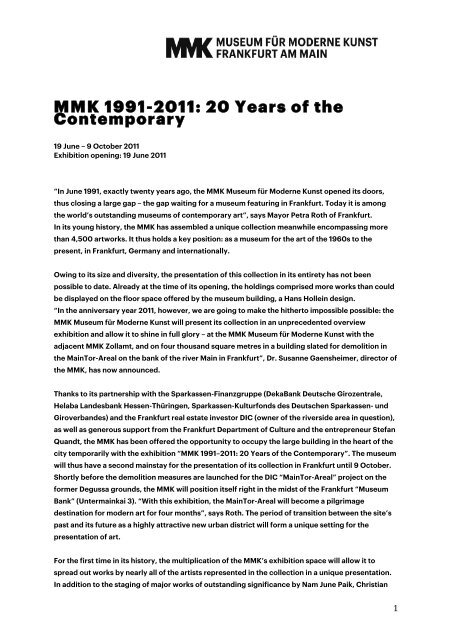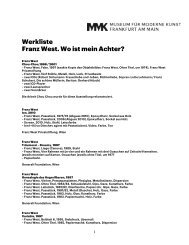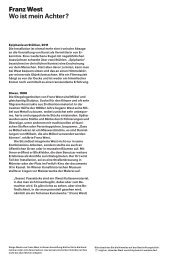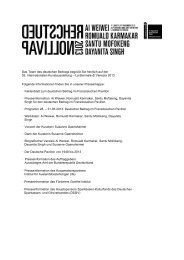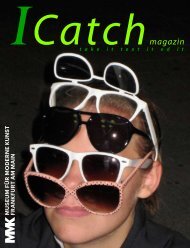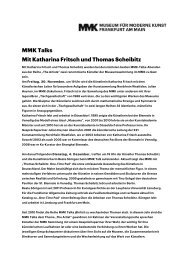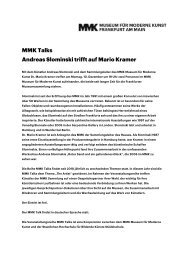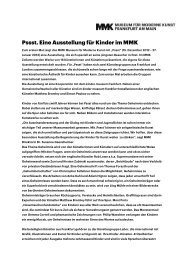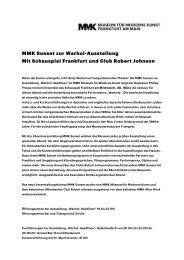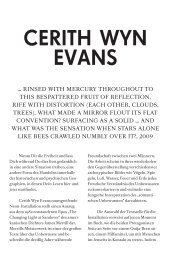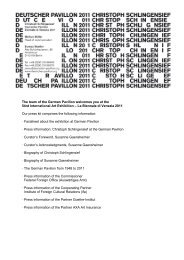20 JahrePressetext_Eng - Museum für Moderne Kunst
20 JahrePressetext_Eng - Museum für Moderne Kunst
20 JahrePressetext_Eng - Museum für Moderne Kunst
Create successful ePaper yourself
Turn your PDF publications into a flip-book with our unique Google optimized e-Paper software.
MMK 1991-<strong>20</strong>11: <strong>20</strong> Years of the<br />
Contemporary<br />
19 June – 9 October <strong>20</strong>11<br />
Exhibition opening: 19 June <strong>20</strong>11<br />
“In June 1991, exactly twenty years ago, the MMK <strong>Museum</strong> <strong>für</strong> <strong>Moderne</strong> <strong>Kunst</strong> opened its doors,<br />
thus closing a large gap – the gap waiting for a museum featuring in Frankfurt. Today it is among<br />
the world’s outstanding museums of contemporary art”, says Mayor Petra Roth of Frankfurt.<br />
In its young history, the MMK has assembled a unique collection meanwhile encompassing more<br />
than 4,500 artworks. It thus holds a key position: as a museum for the art of the 1960s to the<br />
present, in Frankfurt, Germany and internationally.<br />
Owing to its size and diversity, the presentation of this collection in its entirety has not been<br />
possible to date. Already at the time of its opening, the holdings comprised more works than could<br />
be displayed on the floor space offered by the museum building, a Hans Hollein design.<br />
“In the anniversary year <strong>20</strong>11, however, we are going to make the hitherto impossible possible: the<br />
MMK <strong>Museum</strong> <strong>für</strong> <strong>Moderne</strong> <strong>Kunst</strong> will present its collection in an unprecedented overview<br />
exhibition and allow it to shine in full glory – at the MMK <strong>Museum</strong> <strong>für</strong> <strong>Moderne</strong> <strong>Kunst</strong> with the<br />
adjacent MMK Zollamt, and on four thousand square metres in a building slated for demolition in<br />
the MainTor-Areal on the bank of the river Main in Frankfurt”, Dr. Susanne Gaensheimer, director of<br />
the MMK, has now announced.<br />
Thanks to its partnership with the Sparkassen-Finanzgruppe (DekaBank Deutsche Girozentrale,<br />
Helaba Landesbank Hessen-Thüringen, Sparkassen-Kulturfonds des Deutschen Sparkassen- und<br />
Giroverbandes) and the Frankfurt real estate investor DIC (owner of the riverside area in question),<br />
as well as generous support from the Frankfurt Department of Culture and the entrepreneur Stefan<br />
Quandt, the MMK has been offered the opportunity to occupy the large building in the heart of the<br />
city temporarily with the exhibition “MMK 1991–<strong>20</strong>11: <strong>20</strong> Years of the Contemporary”. The museum<br />
will thus have a second mainstay for the presentation of its collection in Frankfurt until 9 October.<br />
Shortly before the demolition measures are launched for the DIC “MainTor-Areal” project on the<br />
former Degussa grounds, the MMK will position itself right in the midst of the Frankfurt “<strong>Museum</strong><br />
Bank” (Untermainkai 3). “With this exhibition, the MainTor-Areal will become a pilgrimage<br />
destination for modern art for four months”, says Roth. The period of transition between the site’s<br />
past and its future as a highly attractive new urban district will form a unique setting for the<br />
presentation of art.<br />
For the first time in its history, the multiplication of the MMK’s exhibition space will allow it to<br />
spread out works by nearly all of the artists represented in the collection in a unique presentation.<br />
In addition to the staging of major works of outstanding significance by Nam June Paik, Christian<br />
1
Boltanski, Ai Weiwei/ Serge Spitzer or Franz Erhard Walther in new constellations and spaces at the<br />
MainTor-Areal, works from the MMK holdings never before shown to the public, for example by<br />
Michel Majerus, Ceal Floyer or Holger Bunk, will be introduced. The spatial concept for the<br />
exhibition building in the MainTor-Areal will be developed in cooperation with Frankfurt architect<br />
Prof. Christoph Mäckler – who incidentally is also responsible for one of the new high-rise sites in<br />
the so-called MainTor Panorama. The artist Tobias Rehberger will install his work Montevideo,<br />
Milan, New York, Moscow, Dubai, Singapore, São Paulo and Tokyo as a temporary museum café,<br />
and with the design of the 600-square-metre roof terrace overlooking the Main and the<br />
development of a visual routing system for the exhibition he will moreover introduce striking visual<br />
accents in the interior and exterior areas of the presentation.<br />
At the building constructed for the MMK <strong>Museum</strong> <strong>für</strong> <strong>Moderne</strong> <strong>Kunst</strong> after a design by Hans Hollein<br />
in Domstrasse in 1991, a concurrent six-month presentation will feature top works from the MMK<br />
such as Roy Lichtenstein’s Yellow and Green Brushstrokes, Andy Warhol’s Green Disaster, Bruce<br />
Nauman’s Perfect Balance, Bill Viola’s The Stopping Mind, Gerhard Richter’s Fußgänger<br />
(Pedestrians) and Douglas Gordon’s Play Dead; Real Time. The post-modern building has lost<br />
nothing of its fascination; on the contrary, it has meanwhile taken on model character.<br />
In the past two decades, many of the pieces on display here have been developed for specific<br />
spaces within the building by artists represented in the collection. No other museum in the world<br />
possesses such a large number of site-specific works.<br />
On the History of the MMK Collection<br />
In 1981, the city of Frankfurt initiated the process of founding a museum of modern art with its<br />
highly acclaimed purchase of works from the former collection of entrepreneur and collector Karl<br />
Ströher of Darmstadt. Already at that time, the foundation was laid for the defining MMK collection<br />
principle: Andy Warhol, Roy Lichtenstein, Claes Oldenburg, Donald Judd, Carl Andre, Gerhard<br />
Richter and Blinky Palermo are not merely represented with single works, but – in every case –<br />
entered the MMK holdings with a substantial number of major works and workgroups. Under the<br />
direction of Prof. Peter Iden, this core collection was already enhanced before the museum’s<br />
opening, for example by Joseph Beuys’s last major work, Blitzschlag mit Lichtschein auf Hirsch<br />
(Lightning with Stag in Its Glare).<br />
Beginning in 1989, MMK director Prof. Dr. Jean-Christophe Ammann consistently developed these<br />
foundations further with workgroups emerging within the context of close cooperation between<br />
the museum and the artists. Bill Viola, James Turrell, Mario Merz, Lothar Baumgarten and On<br />
Kawara all executed their well-known works and workgroups specifically for this setting.<br />
Outstanding collections of works by Alighiero Boetti and Jeff Wall were established and later<br />
expanded within the framework of major retrospectives at the MMK. Hanne Darboven and Bernd<br />
and Hilla Becher likewise entered the collection with workgroups large enough to fill entire rooms.<br />
Substantial workgroups by Frankfurt artists meanwhile known and appreciated all over the world –<br />
for example Peter Roehr, Charlotte Posenenske and Thomas Bayrle – were likewise purchased and<br />
exhibited in the early years of the MMK. In general, Ammann sought to focus his collecting<br />
activities strongly on young artists, the majority of whom had received their training at the art<br />
2
academy Städelschule, among them Heiner Blum, Udo Koch, Manfred Stumpf or Jochem<br />
Hendricks. They bear a relationship to a generation of internationally acclaimed artists such as<br />
Bruce Nauman, Robert Gober, Rosemarie Trockel, Marlene Dumas, Peter Fischli and David Weiss,<br />
and Ilja Kabakov. A further special characteristic of the collection thus also became apparent: it<br />
directs equal attention to all artistic forms of expression. Photography, film and video are collected<br />
to the same degree as the traditional media of painting, prints and sculpture.<br />
With funds from the Dieter and Olga Bock foundation, 431 works were purchased during Ammann’s<br />
period in office, and placed on permanent loan to the MMK. They include ten portfolios each<br />
containing several graphic works. In the context of the withdrawal in <strong>20</strong>05, 395 works were<br />
returned to the Dieter and Olga Bock foundation. That number corresponded to less than eight<br />
percent of the MMK collection’s holdings at present. Fourteen of the most important works for the<br />
collection were repurchased for the MMK by the city at fifty-seven percent of the insurance value<br />
of <strong>20</strong>03. A workgroup by Thomas Bayrle remained in the MMK on permanent loan.<br />
To this day, the purchase of the Ricke Collection in <strong>20</strong>06 represents the largest new acquisition<br />
since that of the Ströher Collection. Udo Kittelmann, MMK director from <strong>20</strong>02 to <strong>20</strong>08, thus<br />
succeeded in substantially expanding the holdings and completing existing workgroups by Richard<br />
Artschwager, Donald Judd and David Reed. The MMK’s focus on American artists was rounded out<br />
with exceptional artistic strategies such as those of Lee Lozano, Gary Kuehn, Cady Noland and<br />
Steven Parrino. The group of room-specific works was further contemporized with examples by<br />
Thomas Demand, Gregor Schneider, Tino Sehgal and Hans-Peter Feldmann.<br />
The commissions granted under the directorship of Dr. Susanne Gaensheimer – head of the MMK<br />
since <strong>20</strong>09 – are entirely in keeping with the museum’s unique image and collection strategy.<br />
Artistic approaches such as those of Cerith Wyn Evans, Sarah Morris, Florian Hecker, Juergen Teller<br />
and M/M (Paris) are outstanding examples of the past two years. For the anniversary year, room<br />
installations by Isa Genzken and Wolfgang Tillmans are planned.<br />
Katharina Fritsch’s Tischgesellschaft (Company at Table), an MMK trademark, belonged to the<br />
collection of the Dresdner Bank. In <strong>20</strong>10, within the context of the Dresdner Bank’s takeover by the<br />
Commerzbank, the work was obtained for the MMK from the latter in the form of a permanent loan.<br />
Works by Tobias Rehberger, Charlotte Posenenske, Dan Flavin and Alighiero Boetti constitute<br />
further enhancements of existing workgroups which made their way into the collection as<br />
permanent loans by the same means.<br />
The MMK has no purchasing budget, and the collection’s successful establishment over the past<br />
twenty years would accordingly not have been possible without major support in the form of<br />
donations and gifts. The MMK would not be in a position to fulfil its mission to serve as a public<br />
museum institution without the great commitment of the citizens of Frankfurt. The cooperation<br />
with private patrons and business will continue to be of tremendous significance in the future as<br />
well.<br />
However great the dedication of the directors and curators of the past twenty years, and however<br />
generous the support from the citizens and business enterprises of Frankfurt, a remarkable<br />
3
indication of the confidence artists place in our museum is the fact that more than one quarter of<br />
our holdings entered the collection as their donations. To cite just one example, more than half of<br />
the room installations in the last exhibition “Not in Fashion: Fashion and Photography of the<br />
Nineties” were donated to the MMK collection.<br />
The Peter Roehr Archive was donated to the MMK by Paul Maenz early this year.<br />
The chief patrons of the anniversary exhibition are the Sparkassen-Finanzgruppe (DekaBank<br />
Deutsche Girozentrale, Helaba Landesbank Hessen-Thüringen, Sparkassen-Kulturfonds des<br />
Deutschen Sparkassen- und Giroverbandes) and the DIC – Deutsche Immobilien Chancen. Further<br />
patrons are the Frankfurt Department of Culture and the entrepreneur Stefan Quandt.<br />
The exhibition will moreover be realized with kind support from Dr. Sesselmann und Kollegen BES<br />
AG and B+G Ingenieure Bollinger und Grohmann. Our mobility partner will be the Deutsche Bahn.<br />
Press contact:<br />
Christina Henneke<br />
Telephone +49 69 212 377 61<br />
Daniela Denninger, Karen Knoll<br />
Telephone +49 69 212 358 44<br />
Fax +49 69 21237882<br />
presse.mmk@stadt-frankfurt.de<br />
4


